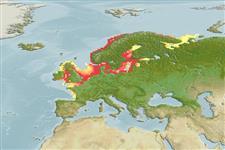分類 / Names
共通名の | 類義語 | Catalog of Fishes(部類, 種) | ITIS | CoL | WoRMS | Cloffa
>
Osmeriformes (Freshwater smelts) >
Osmeridae (Smelts)
Etymology: Osmerus: Greek, osme = odorous; similar to freshly cut cucumbers (Ref. 45335).
More on author: Linnaeus.
Environment: milieu / climate zone / depth range / distribution range
生態学
海; 新鮮な水; 汽水性の; 昇流魚 (Ref. 51243), usually ? - 50 m (Ref. 4545). Temperate; 70°N - 43°N, 9°W - 55°E
North Atlantic: White Sea southward to western coasts of France including Baltic Sea, southern North Sea and British Isles (Ref. 4545); the Gironde estuary is the southern limit of his distribution (Ref. 51442). Landlocked populations in lakes of coastal areas of North, Baltic, White and Barents Sea. North to about 68° N in Scandinavia (Ref. 59043). The former nominal subspecies Osmerus eperlanus eperlanus is recorded from the coasts and drainage of White and Barents Seas westward through Baltic Sea to Denmark and it is primarily lacustrine (Ref. 4545). The former subspecies Osmerus eperlanus schonfoldi (Rutty 1772) is sympatric with the nominate subspecies in parts of Poland, Denmark and the Baltic, and it is primarily anadromous (Ref. 4545).
Length at first maturity / サイズ / 重さ / 年齢
Maturity: Lm 12.8 range ? - ? cm
Max length : 45.0 cm TL オス/雌雄の選別がない; (Ref. 4545); common length : 16.5 cm TL オス/雌雄の選別がない; (Ref. 682); 最大公表体重: 178.00 g (Ref. 6114); 最大記録サイズ: 10 年 (Ref. 682)
背面の脊椎 (合計): 0; 背鰭 (合計): 9-12; 肛門の骨 0; 臀鰭: 12 - 16; 脊つい: 55 - 62. Body long and slim (Ref. 4545). Head rather pointed (Ref. 4545). Snout pointed (Ref. 4545). Upper jaw reaching to hind margin of eye, lower jaw projecting a little (Ref. 4545, Ref. 51442). Teeth in lower jaw larger than those of upper, strong teeth on tongue and canines on vomer (Ref. 4545). Dorsal fin origin behind base of pelvic fins (Ref. 4545). Incomplete lateral line is developed near the head (Ref. 51442). Dorsal side light olive green, flanks silver stripe, belly creamy white (Ref. 4545).
Inhabits marine waters, estuaries and large lakes (Ref. 59043). A midwater species, rarely far from shore, primarily anadromous in the west and lacustrine in the east; shoaling at least during spawning season (Ref. 4545). The essential part of its life is spend in the estuarine zone, with just short incursions in the littoral zone (Ref. 51442). The migratory form is grouping together in the estuarine zone for reproduction (Ref. 51442). Enters the rivers for spawning on sandy or gravely bottoms (Ref. 13696). Spawns in tributaries of lakes or along shallow shores of lakes and rivers on sand, gravel, stones and plant material, preferably in fast-flowing water (Ref. 59043). Reproduction takes place between February and May, depending on the water-temperature (Ref. 51442). Produces 8,000-50,000 yellow eggs with a diameter of 0.6-0.9 mm which adhere to the bottom (Ref. 13696, Ref. 51442). Eggs hatch in 3-5 weeks and the larvae descend to the estuarine zone (Ref. 13696, Ref. 51442). Feeds on shrimps and small crustaceans; larger individuals feed on small fish (Ref. 30578, Ref. 51442). Utilized as foodfish, smoked, as bait and fish oil (Ref. 35388). Smells like cucumber (Ref. 37032, 51442). Locally threatened due to pollution and barriers to migration (Ref. 59043).
Life cycle and mating behavior
成熟 | 繁殖 | 放精 | 卵 | 生産力 | 幼生
Spawns in lower reaches of streams, deeper parts of lake in sand bottoms (Ref. 682). Spawning takes place with the melting of snow (Ref. 682). Many individuals die after the spawning (Ref. 682). Migratory form generally with rapid growth, more eggs, live longer; individuals feeding on fish grow bigger (Ref. 682). ). Becomes sexually mature in 3-4 years (15-18 cm) in brackish populations, 1-2 years (8-10 cm) in freshwater.
Kottelat, M. and J. Freyhof, 2007. Handbook of European freshwater fishes. Publications Kottelat, Cornol and Freyhof, Berlin. 646 pp. (Ref. 59043)
Human uses
水産業: 商業
より多くの情報
協力者画像Stamps, Coins Misc.音シガテラ(食中毒の名前)速度泳ぐ 型式カマOtoliths脳視覚
用具
特記事項
XMLをダウンロードして下さい
インターネットの情報源
Estimates based on models
Preferred temperature (Ref.
123201): 5.5 - 12, mean 9.6 °C (based on 1010 cells).
Phylogenetic diversity index (Ref.
82804): PD
50 = 0.5625 [Uniqueness, from 0.5 = low to 2.0 = high].
Bayesian length-weight: a=0.00417 (0.00269 - 0.00646), b=3.18 (3.05 - 3.31), in cm total length, based on LWR estimates for this species & (Sub)family-body (Ref.
93245).
栄養段階 (Ref.
69278): 3.5 ±0.42 se; based on food items.
回復力 (Ref.
120179): 手段, 1.4年~4.4年の倍増期間の最小個体群 (K=0.15-0.25; tm=2-4; tmax=10; Fec=10,000).
Fishing Vulnerability (Ref.
59153): Moderate vulnerability (43 of 100).
Climate Vulnerability (Ref.
125649): High to very high vulnerability (72 of 100).
Nutrients (Ref.
124155): Calcium = 43.2 [16.7, 100.8] mg/100g; Iron = 0.467 [0.228, 1.197] mg/100g; Protein = 17.5 [14.5, 20.0] %; Omega3 = 0.804 [0.404, 1.637] g/100g; Selenium = 13.8 [6.4, 30.4] μg/100g; VitaminA = 25.1 [9.0, 74.9] μg/100g; Zinc = 0.704 [0.457, 1.105] mg/100g (wet weight);
